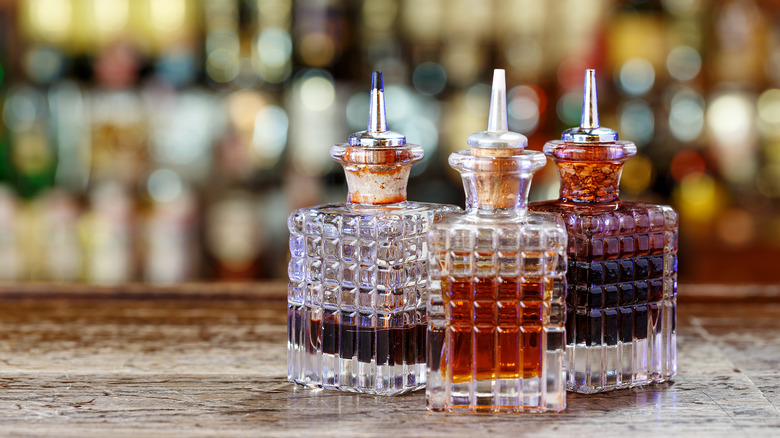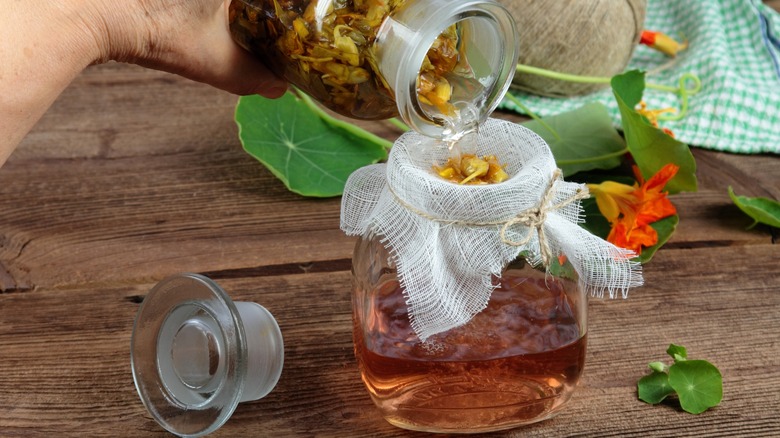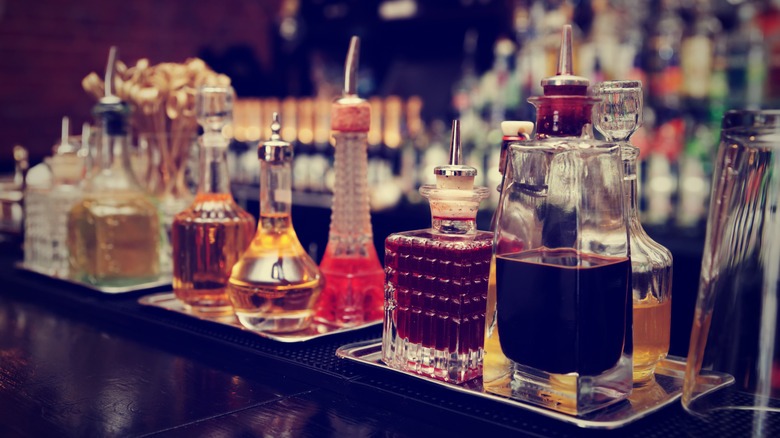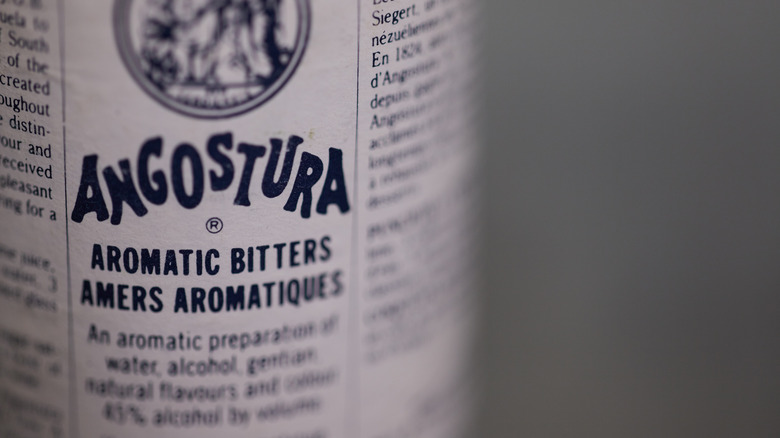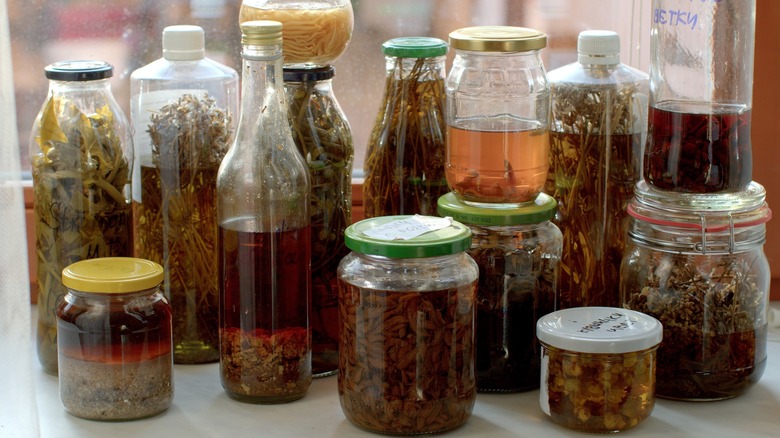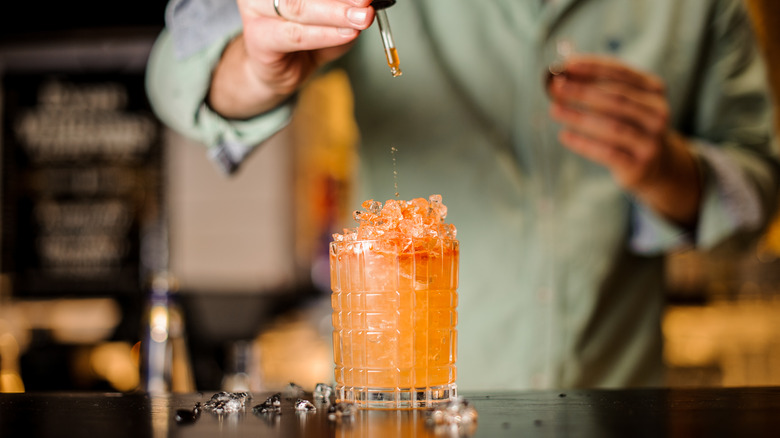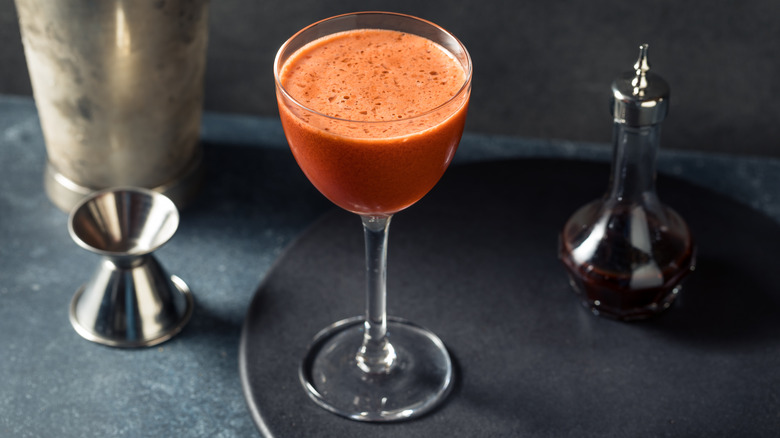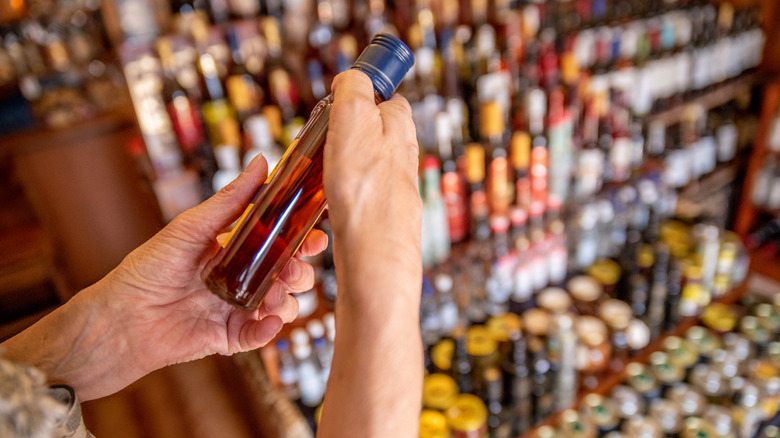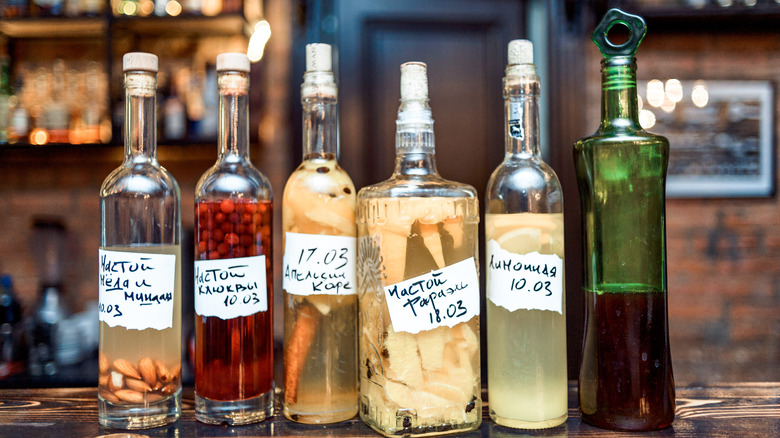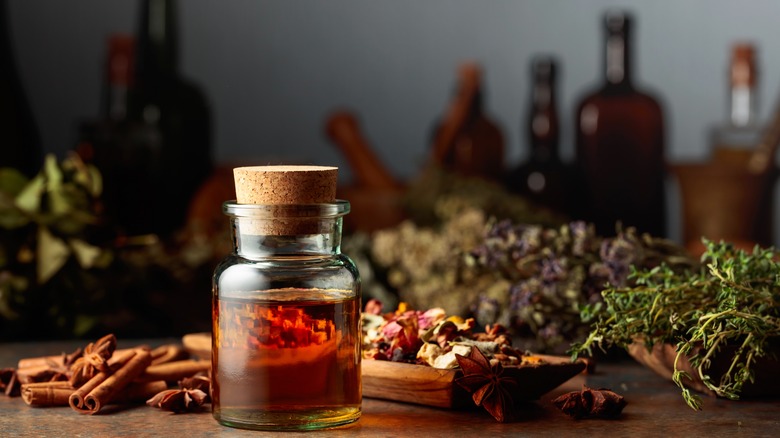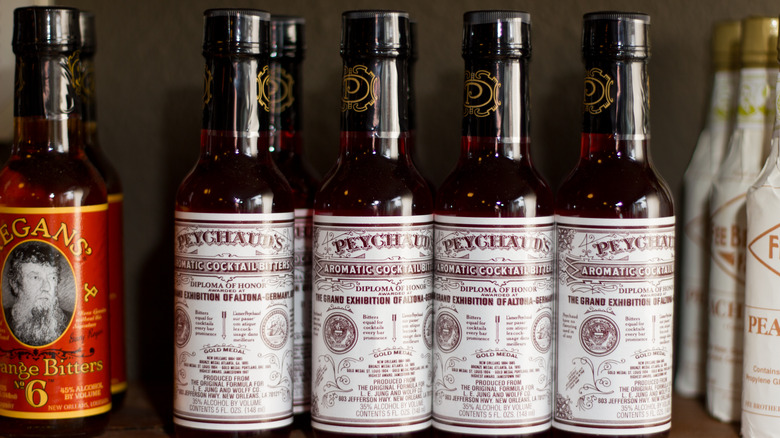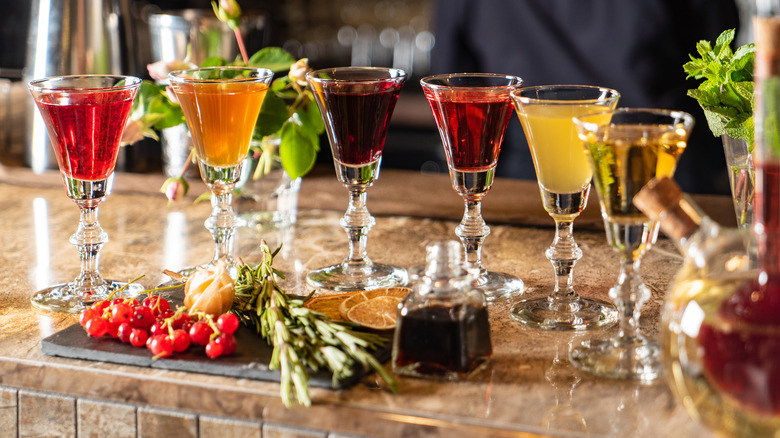A Guide To Bitters And How To Use Them, According To A Bartender
For the casual drinker, cocktail bitters can sometimes be treated as an afterthought, or even forgotten altogether. After all, most recipes only call for a dash or two in a drink, so how important can they be? It's true, they do come in small bottles and are only used in tiny amounts, but there's actually a huge wallop of flavor packed into such a diminutive package. Just as any good cook needs salt and pepper, a mixologist should always have bitters on hand to amplify and unify the flavors of their drinks.
As a professional bartender and cocktail creator, I've worked with and crafted my own bitters for years, and am always amazed at how just a few drops can transform a ho-hum drink into a taste sensation. Whether you're navigating a craft cocktail list or stocking your home bar, this guide is here to help you understand the basics of bitters: What they are, how they're made, and, most importantly, how to use them to elevate your cocktail experience.
What are bitters?
The word "bitter" is thrown around quite a lot when it comes to cocktails. A cocktail can be described as bitter if that's the overwhelming sensation it leaves on your palate. Bitter can also refer to a category of liqueurs that feature bitter ingredients, such as Campari or Fernet-Branca, or any Italian amaro (which literally translates to "bitter"). What we're focusing on here are cocktail bitters, often simply referred to as bitters. Bitters are highly concentrated liquids that have been infused with botanical ingredients. They're intensely flavorful and aromatic, which is why you usually only need a few drops.
For a drink to be balanced, there should be some element of bitterness to it, which serves to offset the flavors in drinks that would otherwise be overly sweet, ensuring the finished beverage isn't cloying. Bitters are an easy way to achieve this. Unlike bitter liqueurs, adding a dash or two of bitters to a drink won't increase its volume, alcohol content, or sweetness level, so you can amp up the flavors and aromas without altering any of your drink's other elements. Cocktail bitters usually include not just bitter-tasting botanicals, but a slew of other ingredients like herbs, spices, fruits, and vegetables. These flavors bring complexity and depth to any drink, together with the balancing bitter notes.
How are bitters made?
There are two main components that go into making bitters: The botanical ingredients and the base liquid. Traditionally, bitters are made by infusing the ingredients in neutral high-proof alcohol, which quickly takes on the flavors and aromas of the infusion, and also acts as a preservative. There are some brands now on the market that use other liquids besides alcohol to make zero-proof bitters, with glycerin being a common substitute.
The process of making bitters is fairly straightforward — the botanicals are left to steep in the base liquid until the flavors and aromas have been fully extracted, at which point the solids are strained out. The ingredients can be infused individually in separate containers and then blended, or they can be added all together in a single infusion. The resulting liquid can then be diluted or sweetened if desired, although you'll want to maintain the bitters' intensity and concentration, so this should be done with a gentle hand. Depending on your ingredients and the volume of your infusion, the process can take anywhere from a day or two to several weeks.
What do bitters taste like?
As you've probably guessed from the name, cocktail bitters do taste bitter. But the bitterness is just one component of the full flavor profile. There are many different styles of bitters out there, which can range from fruity to earthy, rich to zesty, hot and spicy to cool and refreshing. It's tough to generalize exactly what they taste like because there are so many variations, but bitterness is the main element that ties them together.
Bitters get their signature bitterness from a range of botanical ingredients. Common ones include gentian root, burdock root, wormwood, and cinchona bark. Hops, which add bitterness to beer, can also be used. Then, other aromatics and flavorings can be added to round out the profile, like citrus peels, fresh or dried herbs and fruits, leaves, flowers, whole spices, you name it. There's no limit to what can be used in bitters. As long as it has a flavor or aroma that can be extracted, any ingredient is fair game when it comes to the creation of bitters.
One thing to note about bitters is that they're considered non-potable — this means they are not intended to be consumed on their own. Think of them like vanilla extract or baking chocolate, which are incredibly unpleasant and virtually inedible on their own, and need to be mixed with other ingredients.
Classic varieties of bitters
While there are seemingly countless varieties of bitters available today, you can make most cocktails with just a few standard varieties that cover the major flavor profiles. If there is one bottle that should grace every bar, it's Angostura bitters. This brand, which has been in production for almost two centuries, has become synonymous with the style known as aromatic bitters, which is what's called for in many classic cocktail recipes. Bitterness from gentian root is blended with warm baking spices such as allspice, clove, and cinnamon to create its rich, intense flavor.
Peychaud's is another classic brand that's become a style, known for its signature note of anise which gives it a licorice-like flavor. It's lighter and brighter in both color and flavor than Angostura, but still incredibly intense. If you see bitters labeled New Orleans or something similar, they're made with this flavor profile in mind. The third essential style of bitters to know is orange bitters. This variety is lighter, fruitier, and citrus-forward, with less bitterness than the other two. Regan's and Fee Brothers are two well-known brands that make versions of this classic style.
Modern varieties of bitters
The world of bitters has entered a true renaissance thanks to the craft cocktail movement, with an explosion of new brands, styles, and flavors. You can find them made with nuts, chocolate, vanilla, coffee, even tobacco. There are hot and spicy bitters made with peppers, floral bitters like lavender and rose, vegetable bitters flavored with olive, celery, or cucumber, and countless types that use herbs and fruits. There are even bitters based on places and concepts, like umami, Morocco, or the woods.
Some of these modern styles will have fairly limited uses, but having so many bitters with unique and specific flavors can really fuel experimentation behind the bar. If you've never thought of making a spicy cocktail before but suddenly get your hands on some Thai chili bitters, you might be inspired to put together combinations of ingredients you never would have considered otherwise. Bitters that have one dominant flavor are easy to blend with others to create a complex bitter flavor profile — think combinations like orange and chocolate, lime and mint, or lavender and vanilla. Combining bitters together makes the flavor possibilities essentially endless.
How to use bitters
Versatility is one of the best things about bitters. They're obviously great in cocktails, and mocktails too. Since only tiny amounts of bitters are used, even alcohol-based bitters can be used in non-alcoholic drinks, since the amount of alcohol they add is negligible; however, if you're going for true zero-proof drinks, you'll want to opt for glycerin-based bitters. Regardless, bitters can be added a dash at a time to drinks before they're shaken or stirred, to add flavor to the entire concoction. They can floated on top as a garnish, adding a pop of color and aromatic intensity. You can also put a few drops of bitters into an empty glass, swirl to coat the sides, and then build or pour the drink on top. Each of these techniques will give the bitters a subtly different interaction with the rest of the beverage.
As powerful a tool as bitters are behind the bar, their magic doesn't stop there. Their highly concentrated flavors are just as at home in the kitchen. Mix them into marinades, sauces, soups, stews, and salad dressings that need a boost of flavor. Baked goods can benefit from bitters too, in much the same way you'd use vanilla or almond extract.
Famous cocktails that include bitters
If you're seeking inspiration on how to incorporate bitters into your drinks, take a look at some of the world's best-known classic cocktails. The old fashioned and the Manhattan are two famous examples of drinks that prominently feature bitters as an ingredient. Both are seemingly simple recipes with relatively few ingredients, so if you omit the bitters, add too much or too little, or use the wrong kind, you'll notice that something's off as soon as you take a sip. If you're new to using bitters in cocktails, these are great drinks to practice with.
Did you know the martini originally included bitters? Add a few dashes of orange bitters to the gin and vermouth mixture the next time you stir one up to experience the cocktail's traditional flavor. The pisco sour's iconic look is thanks to Angostura bitters dropped atop the cocktail's foamy cap. Two famed New Orleans cocktails, the vieux carré and the sazerac, both showcase Peychaud's bitters (and in the case of the vieux carré, Angostura as well). One of, if not arguably the most bitters-forward cocktail out there is the Trinidad sour, which calls for an entire shot's worth of Angostura bitters. If you're looking for the most intense bitters experience, this is the ultimate drink to try.
Where to buy bitters
Classic bitters — frequently Angostura, but also Peychaud's and various brands of orange bitters — are fairly easy to find. Every liquor store should carry at least one type. And since bitters are technically considered non-potable, despite the fact that most are made with high-proof alcohol, they don't fall under the same restrictions as spirits, wine, or beer. That means you can also find bitters at grocery and other types of stores that don't normally sell alcoholic products. Bitters are also widely available to purchase online from various vendors.
Less common styles of bitters can be more difficult to track down, especially if there's a specific brand, style, or flavor you're seeking out. There are a lot of artisanal bitters producers who make their bitters in small batches, so quantities can be limited. Specialty liquor shops are a good place to start if there's a particular bottle of bitters you're looking for. Many can special order items for you, or at least point you in the right direction.
How to make your own bitters
Making your own bitters is a fun project for any home mixologist. It takes time and some experimentation, but the process is fairly simple and hands-off. All you need is your base liquid, flavoring ingredients, and bottles or jars for each infusion you want to make. Sourcing the specific botanicals can be a challenge, but there are many online herb and spice shops that carry commonly used bitters ingredients.
Once you've gathered everything together, you add the botanical ingredients to your bottle or jar, pour the liquid over them, store them in a cool, dark place, and wait. Give each infusion a smell and taste test every day to see how it's progressing. Some ingredients and combinations infuse faster than others, and there are many variables, such as temperature, that can affect the speed of the process. Once the flavors and aromas are to your liking, strain out the solids using cheesecloth or a coffee filter, do any blending or diluting that you like, and voila — you've got your own signature bitters.
Nutritional information about bitters
Long before cocktails were invented, some versions of bitters existed in the forms of medicinal elixirs and potions crafted and sold by apothecaries to cure various ailments. Many people still use bitters as a health aid, believing that they remedy all kinds of issues, from digestion to inflammation to stress. While more research is needed to prove these claims scientifically, there is some evidence that suggests bitters can in fact provide some benefits to health.
When the sensation of bitterness hits your palate, it causes your digestive system to perk up, producing and releasing stomach acids and saliva which help break down food. This can help ease any stomach problems you may be experiencing, and help with things like heartburn. However, if your digestive system is in good shape, bitters can overstimulate it, creating more acid than you need. This can cause the very same issues that bitters are supposed to cure. So as with any dietary supplement, bitters should be used cautiously to avoid any potential negative reactions.
Because bitters are used in such small amounts, there isn't much to speak of when it comes to caloric and nutritional content. Exact figures will vary based on the particular brand, but generally you're going to find a small handful of calories and negligible amounts of carbohydrate in a serving of bitters.
How to store bitters
Bitters made with high-proof alcohol have no expiration date, and if stored unopened in a cool, dry place, can potentially last indefinitely. Once the bottle is cracked open, though, the introduction of oxygen to the liquid inside can cause it to subtly change in flavor and color. Bitters won't go bad, like perishable items, but the flavor may become less potent over time — think of them like spices in that regard. All the same, even opened, these kinds of bitters can last largely unchanged for years, decades, or even longer.
For bitters made with non-alcoholic base liquids, the shelf life will likely be shorter. If you have glycerin-based or other types of bitters, make sure to check the bottle for a "best by" date and use accordingly. Either kind of bitters can be kept out at room temperature, as both alcohol and glycerin have preservative qualities. For the best chance of retaining their flavors and aromas, once the bottles are opened, store them in the refrigerator. The lower temperature will keep them from oxidizing too quickly.
Substitutes for bitters
Finding a proper substitute for cocktail bitters can be a challenge, as there isn't much out there that can compete when it comes to flavor concentration. However, if you find yourself craving a Manhattan and your bottle of Angostura is bone dry, it's not the end of the world. There are a few different ways to provide a similar effect to what bitters bring. Depending on how well-stocked your spice rack or back bar is, these can be easy fixes if you're out of bitters.
While most people likely don't have bitter roots lying around, other flavoring elements of bitters may be close at hand that you can use to flavor your drink. If you're out of orange bitters, peel some citrus and stir or shake it in with the rest of the cocktail. Same goes for spices, if you're looking to recreate aromatic bitters — crush or grind some clove, cinnamon, or whatever whole baking spices you have, and let them sit in contact with the drink for a bit before stirring, shaking, and straining them out.
If you're short on these types of ingredients but stocked up on liqueurs, chances are you may have a bottle that's bitter enough to serve as a substitute. Since liqueurs are sweetened and diluted, they won't operate exactly like bitters, but the flavors will be similar. Red bitter liqueurs like Campari or Aperol, or darker styles like amaro and Fernet can provide that bitter balance.
